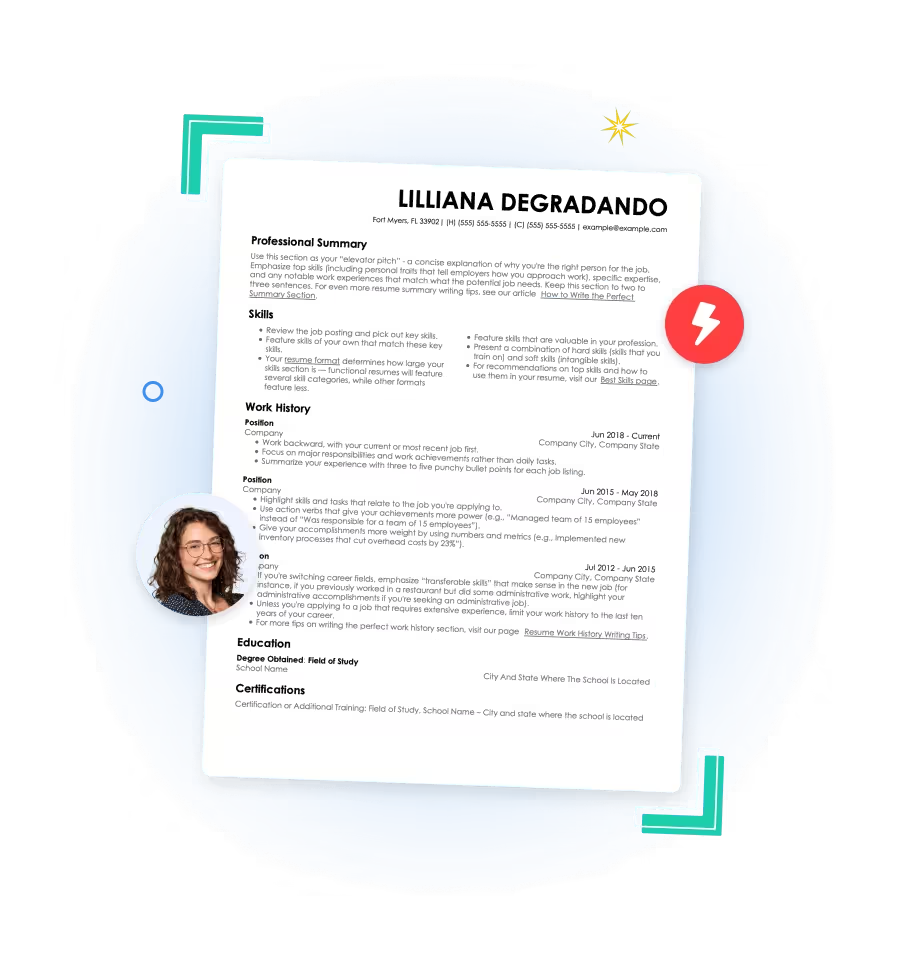While you may have given a lot of thought to the content of your resume, it’s likely that you haven’t given much thought to how it looks.
You probably change up your hairstyle every few years to stay current. Chances are that your resume probably hasn’t had a facelift in quite some time.
How can you create a resume format that is both visually appealing and packed with keywords and phrases that will help you get the job?
Choosing a format is the first step in changing your resume’s appearance. There are three main resume formats to consider:
- The chronological resume format.
- The functional resume format.
- The combination resume format.
The resume format you choose depends on several factors, such as your experience level and work history details.
Explore the advantages and disadvantages of the top resume formats below to determine which approach best showcases your qualifications effectively and professionally.
The Chronological Format
With more than half of all recruiters reporting a preference for the chronological resume format, using this layout is a no-brainer for many job seekers.
The chronological resume format organizes your skills, work history, and education in an easy-to-digest document.

Recruiters and hiring managers love this format because it’s linear and easy to read. Work experience is listed by date, in chronological order, from the most recent job to the least recent job. This resume format makes it easy for hiring managers to track your career growth.
This straightforward approach works well for those with a consistent work history within a single industry. However, if you have blemishes in your professional past — jumping from job to job or long stretches of unemployment — this resume format will illuminate those.

Pros & cons of the chronological resume format
Pros:

- This is the resume format preferred by most recruiters.
- A chronological resume format is linear and easy to read.
- This resume format shows off a consistent work history.
Cons:




- This resume format reveals periods of unemployment.
- It may downplay transferable skills for career changers.
- Older, less relevant experience is often emphasized.
The Functional Format
As mentioned, the chronological format isn’t the right choice for everyone, particularly those with little work experience or a spotty or blemished work history.
For these job seekers, the perfect resume format is the functional format, designed to highlight your strengths and limit the visibility of your weaknesses.
Using the functional resume format helps you zero in on your marketable skills. Rather than listing your past jobs chronologically and detailing the duties and skills related to each one, the functional resume format instead groups together the critical hard and soft skills you’ve acquired through your education, volunteer work, and life experiences. Your work history is included. However, it appears as a simple list rather than as the meat and potatoes of the resume.
This resume format is ideal for students, as it emphasizes educational achievements that might otherwise be overshadowed in a chronological format. It’s also an excellent fit for freelancers with diverse gig-based work or professionals who have transitioned — or are planning to transition — into a new career path.
In short, the functional resume format helps you demonstrate your talents and frees you from the linear format of the chronological resume. The downside? Some recruiters find this format difficult to decipher, which could put you at a disadvantage in the job search.


Pros & cons of the functional resume format
Pros:




- The functional resume format focuses on your marketable skills rather than your employment history.
- For those with limited work experience, this format helps demonstrate skills acquired in school, through travel, or other experiences.
- This is a great format for recent grads, freelancers, and those who have changed industries.
Cons:




- Some recruiters find this format difficult to read.
- This may not be the right resume format for those with consistent work histories.
- For job seekers with in-demand skills, this format might not highlight them sufficiently.
Combination Resume Format
The combination resume format incorporates the best of the chronological and functional formats, borrowing from the strengths of each to produce a resume format that will work for many job seekers.
The combination, or hybrid, resume merges elements of the chronological and functional formats, blending their strengths into a cohesive resume style. This format emphasizes job seekers’ relevant skills while providing key details about their work history in a single, well-rounded document.
The combination resume, which integrates elements of chronological and functional formats, is suitable for many job seekers. It is particularly advantageous for individuals with strong work histories transitioning to a different industry. This format effectively highlights their career progression while emphasizing the hard and soft skills relevant to their target role.
This format also works well for those reentering the workforce after a long break. For those who may have left the workforce to raise children, care for an elderly parent, or because of a layoff, the combination format allows them to showcase their past jobs and highlight skills they may have acquired during their time away, such as volunteer work. Hybrid resumes can also help reduce the visibility of employment gaps by focusing on marketable skills rather than the dates of past employment.


Pros & cons of the combination resume format
Pros:




- This resume format combines the strengths of chronological and functional resume formats.
- The combination resume format highlights a job seeker’s relevant skills and gives some details about their work history.
- This format works well for those reentering the workforce after a hiatus and those making significant career changes.
Cons:




- While this style is gaining popularity, many recruiters still prefer the chronological format.
- This resume format can be longer than others, which some recruiters see as a negative.
More Popular Resume Formats
Now that you understand the differences between the three major resume formats let’s take a look at some real-world examples to see how they look.
Professional Resume Format

This Resume Format is Great For:
Our professional resume format is our most popular chronological resume template. This format offers job seekers a clean, classic look and highlights a solid work history. Professionals of all career stages can use this format to land a new job in their chosen industry or take the next step in their careers.
Professional Resume Format Pros:
Our professional resume format is another popular chronological resume template. The clean, classic look gives a well-rounded, linear overview of job seekers’ accomplishments. The understated design maximizes the use of space on the page while presenting your abilities in an organized, easy-to-ready layout.
Professional Resume Format Cons:
Career changers, academics, and others with non-linear career progression may need a different format, such as the functional format, which focuses more on skills than work history.
Additional Writing Tips for the Professional Resume Format:
Don’t forget to quantify your past accomplishments by adding metrics when detailing them in your work experience section.
Student Resume Format

This Resume Format is Great For:
The student resume format is great for — you guessed it! — students and other job seekers with limited work experience. This combination resume format has a touch of personality and focuses on the job seeker’s skill set more than their work history.
Student Resume Pros:
This resume format combines the strengths of both the chronological and functional resume formats, which allows you to show of the work experience you do have while focusing on your hard and soft skills that might be relevant to the job at hand.
Student Resume Cons:
The student resume format is a combination resume, and while this style is gaining popularity, many recruiters still prefer the more traditional chronological format.
Additional Writing Tips for the Student Resume Format:
As a student, you might not have a lot of work experience, but you have acquired some hard and soft skills. Use the student resume format to your advantage by highlighting the hard and soft skills you’ve acquired through your education, volunteer work, and even travel.
Executive Resume Format






This Resume Format is Great For:
Job seekers with a consistent work history looking for a management or executive role.
Executive Format Pros:
Our executive resume format helps you highlight your professional accomplishments and managerial successes using a traditional, chronological format appropriate for use across industries. Plus, recruiters prefer the chronological format.
Executive Format Cons:
If you’ve had periods of unemployment, this chronological format will make those more obvious than some other formats. Additionally, the chronological resume may not be ideal for applicants who have had very long careers as it can inadvertently reveal their age.
Additional Writing Tips for Executive Format:
Those at the executive level have typically enjoyed great professional success. Be sure to back up your accomplishments with stats and data that show what you’ll be bringing to the table for your next employer.
Simple Resume Format






This Resume Format is Great For:
Whether you’ve been working for a year or 10 years, the simple resume format is an excellent choice for anyone with professional experience. Its sleek design and fresh font make it a classic with a twist.
Simple Format Pros:
The simple resume format spotlights your accomplishments while adding a splash of personality, which can help you stand out in a sea of plain, black-and-white resumes. The chronological format calls attention to your steady work history and allows you to detail the skills you acquired in each role.
Simple Format Cons:
For those with minimal work experience or job seekers who’ve experienced periods of unemployment, the chronological layout of the simple format can make those more evident than some other formats.
Additional Writing Tips for Simple Format:
This format is simple but mighty, especially when you take the time to highlight both your hard and soft skills, like stellar written and verbal communication.
Modern Resume Format






This Resume Format is Great For:
Job seekers looking for a classic chronological resume template with some personality will like the modern resume template. It’ll show off your professional progression and your hard and soft skills without skimping on style.
Modern Format Pros:
The modern resume format will stand out in a stack of black-and-white resumes while honoring the traditional chronological format that recruiters prefer. This format works best for job seekers who have work experience and who haven’t experienced major employment gaps.
Modern Format Cons:
Multiple job changes, periods of unemployment, and other blemishes on your work history are made more obvious in this resume format. For these types of workers, a functional or combination resume format may be more advisable.
Additional Writing Tips for Modern Format:
Job seekers with substantial work histories have a significant advantage. Enhance your resume by incorporating relevant soft skills that highlight what makes you exceptional in your role.
